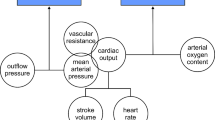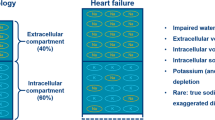Summary
With the system recently developed, continuous glucose determinations and programmed infusions are also possible in the freely mobile dog. The animal is kept in a dogbox and wears a dogjacket to which a plastic plate is fitted. A bite- and twist-proof flexible hollow pipeline is connected rigidly to this plate. The pipeline goes through a hole in the centre of the roof of the dogbox to a newly developed rotary adaptor system for three catheters. The rotary adaptor is fitted to a vertical sliding bar system with countermovement. The three catheters run along the inside of the hollow pipeline down to the animal's back where two of them connect to a double-lumen catheter (DLC) inserted in the jugular vein. Through one tube, heparin solution is transported to the tip of the DLC. There it is sucked back together with blood through the second tube and transported to the glucose analyser. Through the third catheter, insulin or glucose is infused into the other jugular vein. The flow of the extracorporeally heparinized blood is regular. Occlusion of the DLC does not occur. During a 24-h study period, 70 ml of blood are taken from the animal. The DLC is simple to manufacture and, if suitably developed, might also be used in humans instead of the usual rigid double-lumen plastic cannular system.
Zusammenfassung
Die vorgestellte Technik ermöglicht die kontinuierliche Blutglucosebestimmung und Insulin- bzw. Glucoseinfusion beim wachen, frei beweglichen Hund über mehrere Tage. Das Tier befindet sich in einer Box für Hunde. Es trägt ein Jackett, auf dessen Rücken eine Platte fixiert ist. An ihr inseriert ein biß- und verwindungsfester Schlauch, der durch die Boxendachmitte mit einem auf einem Gegenzugsystem montierten Rotationsadapter für drei Katheter fest verbunden ist. Die drei Katheter verlaufen geschützt durch das Lumen des Schlauches abwärts zum Tier. Dort sind zwei Katheter mit einem doppellumigen, flexiblen, in der Jugular-Vene liegenden Kathetersystem verbunden. Über den einen Strang wird Heparin-Lösung zur Spitze des doppellumigen Katheters gefördert und von dort zusammen mit angesogenem Blut über den zweiten Strang zum Glucoseanalysator transportiert. Über den dritten Katheter wird Insulin bzw. Glucose in die andere Jugular-Vene infundiert. Der Fluß des extracorporal heparinisierten Blutes ist regelmäßig. Katheterverstopfungen werden nicht beobachtet. Während 24 h werden dem Tier maximal 70ml Blut entnommen. Das einfach herstellbare, flexible, doppellumige Kathetersystem zur Entnahme von extracorporal heparinisiertem Blut könnte bei entsprechender Weiterentwicklung auch beim Menschen anstelle des üblichen starren Kunststoff-Kanülen-Systems benutzt werden.
Similar content being viewed by others
Literatur
Albisser AM et al. (1974) An artificial endocrine pancreas. Diabetes 23:389–396
Albisser AM (1971) A double-lumen cannula for blood sampling. United States Patent No. 3.610.226
Albisser AM, Leibel BS (1977) The artificial pancreas. Clin Endocrinol Metab 6:457–479
Branham GW (1976) A device for continuous intravenous fluid injection in dogs. Lab Anim Sci 26:75–77
Gander RE et al. (1975) An all-plastic double-lumen catheter for continuous blood sampling. Med Instrum 9:187–188
Garrioch DB (1975) Continuous blood sampling: a modified double-lumen catheter. Clin Sci Molec Med 49:121–124
Kadish AH (1964) Automation control of blood sugar. Pt. 1: a servomechanism for glucose monitoring and control. Am J Med Electronics 3:82–86
Kurse-Jarres JD et al. (1969) Das Glucoseverhalten im Venenblut bei kontinuierlicher Registrierung. I. Reduktometrische und enzymatische Analyse mit dem Autoanalyser. Klin Wochenschr 47:462–469
Kawamori R et al. (1978) Importance of insulin secretion based on the rate of change in blood glucose concentration in glucose tolerance, assessed by the artificial beta cell. Acta Endocrinol 87:339–351
Sailer D et al. (1974) Zur kontinuierlichen Glukosebestimmung in vivo. Biomed Technicol 19:134–137
Spathis GS et al. (1966) A simple catheter for continuous intravascular sampling. Lancet 30:266–267
Weller C et al. (1960) Continuos in vivo determination of blood glucose in human subjects. Ann NY Acad Sci 97:658–668
Author information
Authors and Affiliations
Rights and permissions
About this article
Cite this article
Geisen, K., Reisig, E. & Härtel, D. Kontinuierliche Blutglucosemessung und Infusion bei wachen, frei beweglichen Hunden. Res. Exp. Med. 179, 103–111 (1981). https://doi.org/10.1007/BF01851978
Received:
Accepted:
Issue Date:
DOI: https://doi.org/10.1007/BF01851978




